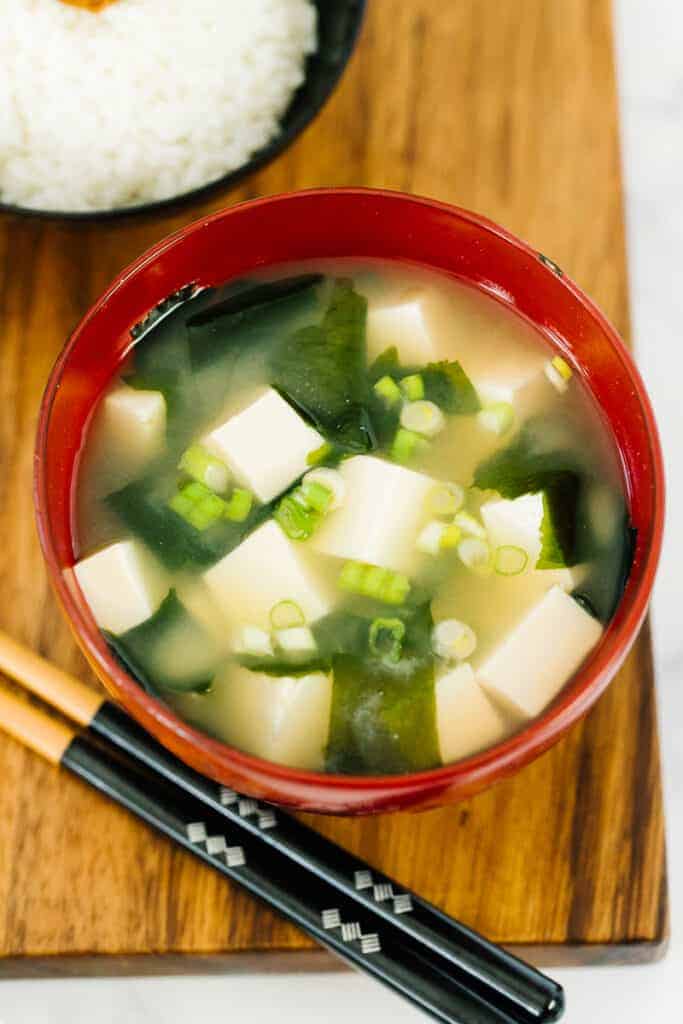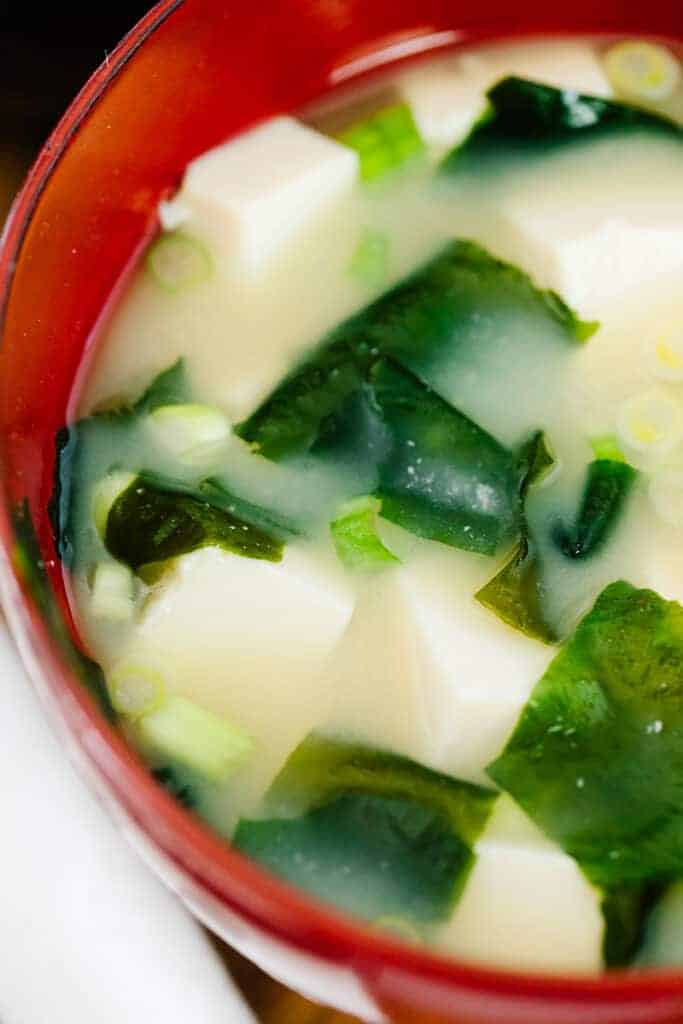This post may contain affiliate links, which means I earn a small commission if you purchase something I recommend - at no additional cost to you! Thank you for supporting this blog!
Miso soup is a healthy Japanese staple dish that can be found at almost any meal. Here’s a simple recipe for beginners without any complicated processes.

Simple Miso Soup is my ultimate comfort food. Give me a bowl of hot, steamy rice with it and I’m transported back to my childhood. I love making miso soup when I’m not feeling well or when it’s super cold.
There’s limitless ways and varieties to make miso soup, but here’s my super easy and simple version. Let me answer some frequently asked questions about miso soup first.
Miso Soup Recipe that’s Easy
Traditional miso soup is made with homemade dashi (dah-she) stock, miso paste, and fillings like silken tofu and wakame (seaweed).
Dashi is a clear stock made from kombu (kelp) and bonito flakes. It is used in so much Japanese cooking. My recipe doesn’t use homemade broth, but instead used two “shortcuts” for dashi.

Ingredients for Simple Miso Soup
- Dashi stock (or water with dashi powder)
- Miso (me-so)
- Dried wakame (wah-kah-meh)
- Silken tofu
The typical ratio for miso soup is 1 tablespoon of miso per cup of liquid.
Additional add-ins for Miso Soup
Since miso soup is enjoyed with almost every meal in Japan, people find tons of creative ways to mix it up. Very simple miso soup is usually just wakame and tofu, but you can customize it to your taste.
If you’re using any hard ingredients that require boiling to soften, add them with the dashi and let them boil until tender.
If you have soft ingredients like tofu or spinach, add them in after boiling so they don’t break up.

My favorite combination my mom always made was peeled potato cut into sticks, sliced onion, and sliced carrots.
- Green onions (I almost always add in a small handful to each bowl)
- Aburrage cut into strips (fried tofu)
- Sliced onions (boiled with the dashi until soft)
- Potato sticks (boiled with the dashi until soft)
- Carrots
- Cabbage
- Mushrooms
- Spinach (added to wilt at the end with miso)
- Or any other vegetable!
Miso Soup without Dashi
This recipe contains dashi, but not homemade dashi. You cannot really make real miso soup without it and I do not recommend any recipe that substitutes this with vegetable broth or chicken broth.
The flavor is wildly different, and you won’t get the same results.
What can I use instead of Dashi in Miso Soup?
I use one of two “substitutes” for homemade dashi: miso paste with dashi added, or dried dashi powder.
Dashi powder is much easier to find, and you can use it for multiple things. I recommend a Japanese brand (over Korean or Chinese) and to follow the manufacturer’s directions on the ratio of dashi powder to water to make dashi stock.
Ajinomoto brand’s HonDashi is my favorite.
If your local Asian market has it, an even EASIER version is to use miso paste that has dashi stock added to it. These packages will probably be in English (vs. Japanese) so you’ll be able to identify it.
It’s not as common, but it’s much easier and more accessible for those making miso soup at home for the first time.

What can I use instead of Dashi Powder?
To make “real” miso soup, you really can’t substitute one of the main ingredients.
If you can’t find the powder, make homemade, or find miso with dashi, I recommend ordering it online for best results.
How Long Does Miso Last in the Fridge?
Miso is a fermented paste that lasts FOREVER in the fridge. It can literally last a year in the fridge.
I recommend using it within a couple of months with a piece of plastic wrap pressed up against the miso powder to reduce exposure to the air.
Which is Better? Red, or White Miso?
There are thousands of varieties of miso and every region in Japan has different specialties. I personally prefer a red miso, which is actually brown.
It has a richer, saltier flavor than white miso. If you’ve ever had miso soup before, this is probably what you’re used to.
Of course, if you like white miso, use that.

Can you eat miso paste raw?
Yes, you can eat miso paste raw. It can be used in all sorts of applications from cold dishes to desserts.
The only important thing to remember is to NEVER boil miso paste.
Boiling miso is a big no no because it kills all the healthy probiotic bacteria (it’s fermented, after all). Boiling the miso paste also damages the flavor and aroma.
Miso paste is always dissolved or stirred in at the end of the cooking process.
Is miso vegan?
Miso by itself is fermented soybeans mixed with salt and a special kind of mold called Koji rice. These ingredients ferment together and create this ultra umami, healthy paste called miso.
Miso is vegan, but miso soup when made with dashi is not vegan as dashi is made from fish and/or shellfish.

Other Asian Dishes
- Sunomono – Japanese Cucumber Salad
- Instant Pot Hot and Sour Soup
- Egg Drop Soup
- Cream Cheese Wontons (Air Fryer or Deep Fried)
- Shabu Shabu Recipe in the Instant Pot
- Tuna Poke Bowl
- Instant Pot Kalua Pork
- Inari Sushi


Simple Miso Soup
INGREDIENTS
- 2 cups dashi stock prepared (see notes)
- 1-2 teaspoons dried wakame
- 1 1/2 tablespoons chopped green onion
- 2 heaping tablespoons miso paste
- 1/2 cup silken tofu cubed
INSTRUCTIONS
- Boil the dashi, then add wakame and green onion.
- Turn off the heat, then using a spoon or fork, gently dissolve the miso paste into the dashi. Do not boil the soup after adding miso.
- Add tofu, then let stand for about 5 minutes to warm through.










Love the Japanese content, Lisa! As always, your recipes are easy to follow, not too complicated, and I look forward to making this!